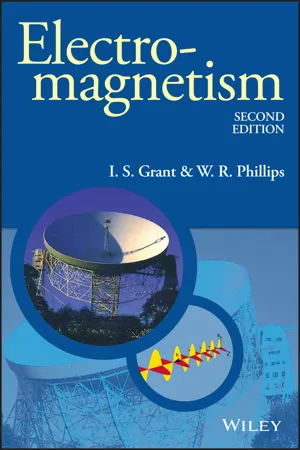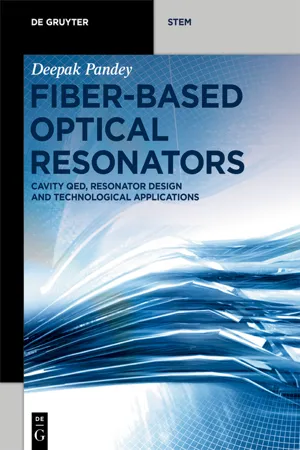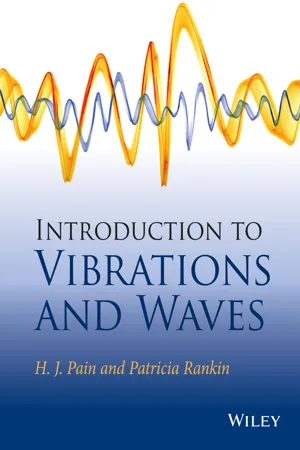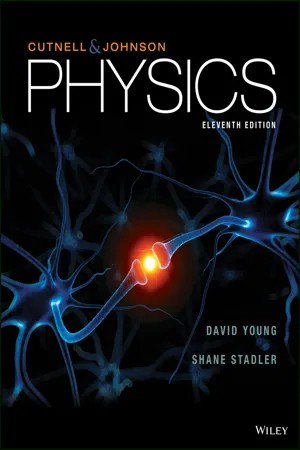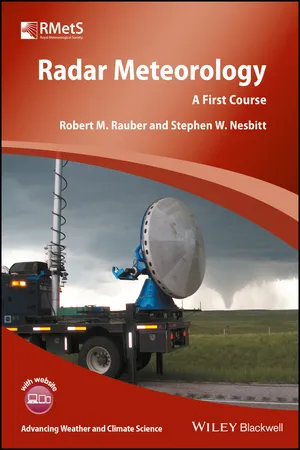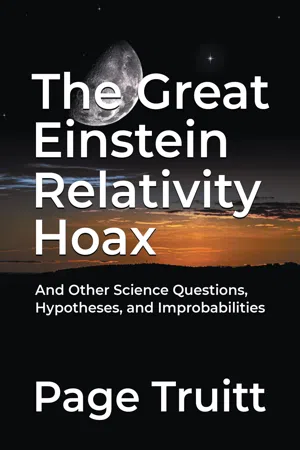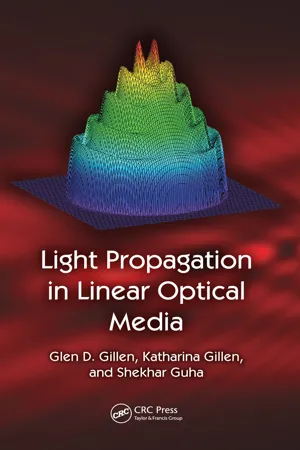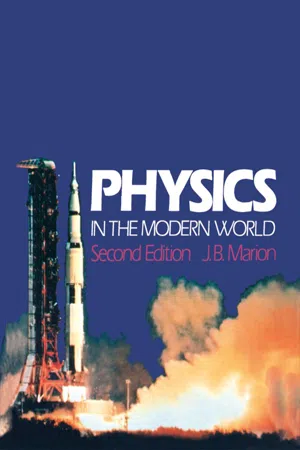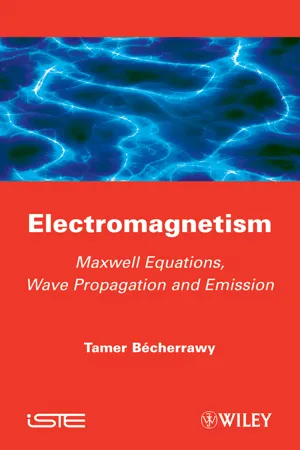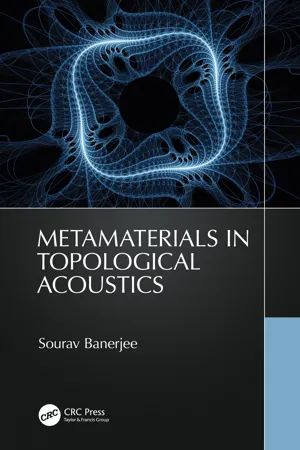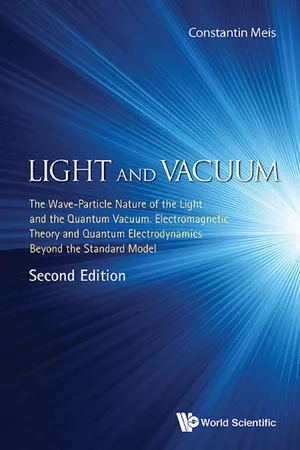Physics
How Are Electromagnetic Waves Produced
Electromagnetic waves are produced by the acceleration of charged particles. When charged particles are accelerated, they create changing electric and magnetic fields, which propagate through space as electromagnetic waves. This process occurs in various natural and human-made phenomena, such as the movement of electrons in an antenna or the oscillation of charged particles in the sun.
Written by Perlego with AI-assistance
Related key terms
Related key terms
1 of 4
Related key terms
1 of 3
12 Key excerpts on "How Are Electromagnetic Waves Produced"
- Tamer Bécherrawy(Author)
- 2013(Publication Date)
- Wiley-ISTE(Publisher)
Chapter 6Electromagnetic WavesA remarkable property of Maxwell’s equations (that was not possible to foresee before the formulation of the electromagnetic theory) is that they have solutions representing electromagnetic waves propagating at the speed of light in matter and in vacuum. The existence of these waves was experimentally confirmed, in 1890 by Hertz, who succeeded in producing them and verifying that they have the same propagation, interference, diffraction and polarization properties as light waves. Thus, Maxwell theory has enabled us to understand the nature of light as electromagnetic waves with very short wavelengths. Actually, we can produce and detect electromagnetic waves of frequencies varying between 10−2 Hz and 1032 Hz, that is, of wavelengths varying between 1010 m and 10−24 m. They play a very important part in nearly all branches of physics and have a considerable impact on economic, social, political and intellectual life. In this chapter, we recall the principal results of the electromagnetic theory, namely Maxwell’s equations. We discuss their wave solution and some applications of electromagnetic waves.6.1. Principal results of the electromagnetic theory
The basic concepts of the electromagnetic theory are the electric field E and the magnetic induction field B (also called magnetic field for short) defined by their action on a charge q of velocity v[6.1]In the presence of dielectrics, we also have to introduce the electric displacement (also called electric induction ) D = εo E + P where εo = 8.8541878 x10−12 A2 s4 /kg.m3is the electric permittivity of vacuum and P is the density of polarization (or simply polarization ), i.e. the electric dipole moment of the dielectric per unit volume. In the presence of magnetic materials, we also have to introduce the magnetic field strength (also called magnetic intensity ) H = B/µo - M where µo = µo = 4π x 10−7 kg.m/A2 s2 is the magnetic permeability of vacuum and M is the intensity of magnetization (or simply magnetization- eBook - ePub
- I. S. Grant, W. R. Phillips(Authors)
- 2013(Publication Date)
- Wiley(Publisher)
CHAPTER 11
Electromagnetic waves
We have already outlined in section 10.4 how a spark discharge can produce changing electric and magnetic fields that propagate outwards from the changing charge and current distributions in the spark. Any charge distribution which changes with time, or any varying current, can give rise to a radiated electromagnetic field. However it is only when the changes are rapid that the radiated fields are large enough to carry away an appreciable fraction of the power dissipated in the system. In practice radiated fields associated with varying currents are usually unimportant unless the variations contain frequencies higher than 100 kHz. This is about the lowest frequency used for commercial transmission of radio waves.In this chapter we will consider some general properties of electromagnetic waves propagating in free space or in homogeneous isotropic media. We will also consider what happens to simple waves at a plane boundary between two media. The electromagnetic field will be treated classically. This means that we will assume the energy in the waves to be distributed continuously throughout the space occupied by them, and the energy to depend in some way on the macroscopic fields E, D, B and H. The same approach was adopted in the discussion of the energies in static electric and magnetic fields. The media in which the waves are travelling will also be treated classically, as if they were continuous, and will be characterized by macroscopic quantities such as relative permittivity ε , relative permeability μ , and electrical conductivity σ . These quantities vary with frequency, although the electrical conductivity of almost all substances is effectively constant for most frequencies that we will consider. The interpretation of the parameters ε , μ and σ throws much light on the microscopic description of matter, but these problems will rarely be mentioned in this chapter. The classical theory provides a good description of most electromagnetic phenomena for frequencies below about 1011 - eBook - ePub
Fiber-Based Optical Resonators
Cavity QED, Resonator Design and Technological Applications
- Deepak Pandey(Author)
- 2024(Publication Date)
- De Gruyter(Publisher)
These discoveries made it clear that the two seemingly different phenomena, electricity and magnetism, are both produced by electric charges depending on whether they are stationary or in motion. With the realization of electromagnetism as a unified theory, an explicit mathematical description of electromagnetism emerged through the meticulous theoretical work of Maxwell. Simple differential equations derived from his work contained all the essence of the electromagnetic phenomenon. Furthermore, Maxwell expanded upon the existing theory by introducing an additional term, known as the displacement current to Ampere’s law. This addition proved crucial for a comprehensive understanding of electromagnetic behavior. After further research and simplification by British physicist, Oliver Heaviside, these equations were finally condensed into the currently renowned four Maxwell electromagnetic wave equations, which present a concise and elegant description of electromagnetic waves, including light and the associated phenomena in wave optics.Figure 1.3 The line integral of the magnetic field for a closed loop is related to the enclosed current sources,∮ B · d l =.μ 0∫ sJ · d A1.2 Electromagnetic waves
An electromagnetic wave (EM-wave) consists of oscillating electric and magnetic fields at each point in space and time. These fields exhibit sinusoidal patterns, much like the oscillation of particles in a mechanical wave traveling through a medium. EM-wave is created by the interaction of electric charges and magnetic fields following the principles of electromagnetism. EM-waves are characterized by their frequency (ν) and wavelength (λ), which are related by the equation:c = ν λ, where c is the speed of light in a vacuum. This equation highlights that electromagnetic waves travel at the speed of light.The electromagnetic spectrum encompasses a wide range of frequencies and wavelengths, including radio waves, microwaves, infrared waves, visible light, ultraviolet waves, X-rays, and Gamma rays. Each segment of the spectrum corresponds to a different range of frequencies and wavelengths, with visible light being the portion that can be detected by the human eye. - eBook - ePub
- H. John Pain, Patricia Rankin(Authors)
- 2015(Publication Date)
- Wiley(Publisher)
Electromagnetic waves arise whenever an electric charge changes its velocity. Electrons moving from a higher to a lower energy level in an atom will radiate a wave of a particular frequency and wavelength. A very hot ionized gas consisting of charged particles will radiate waves over a continuous spectrum as the paths of individual particles are curved in mutual collisions. This radiation is called ‘Bremsstrahlung’. The radiation of electromagnetic waves from an aerial is due to the oscillatory motion of charges in an alternating current flowing in the aerial.Figure 9.1 shows the frequency spectrum of electromagnetic waves. All of these waves exhibit the same physical characteristics.Wavelengths and frequencies in the electromagnetic spectrum.Figure 9.1It is quite remarkable that the whole of electromagnetic theory can be described by the four vector relations in Maxwell’s equations. In examining these relations in detail we shall see that two are steady state; that is, independent of time, and that two are time-varying.The two time-varying equations are mathematically sufficient to produce separate wave equations for the electric and magnetic field vectors, E and H, but the steady state equations help to identify the wave nature as transverse.The first time-varying equation relates the time variation of the magnetic induction, μH = B, with the space variation of E; that isThis is nothing but a form of Lenz’s or Faraday’s Law, as we shall see.The second time-varying equation states that the time variation of εE defines the space variation of H, that isAgain we shall see that this is really a statement of Ampere’s Law.These equations show that the variations of E in time and space affect those of H and vice versa. E and H cannot be considered as isolated quantities but are interdependent.The product εE has dimensionsThis charge per unit area is called the displacement charge .Physically it appears in a dielectric when an applied electric field polarizes the constituent atoms or molecules and charge moves across any plane in the dielectric which is normal to the applied field direction. If the applied field is varying or alternating with time we see that the dimensions of - eBook - ePub
- John D. Cutnell, Kenneth W. Johnson, David Young, Shane Stadler(Authors)
- 2018(Publication Date)
- Wiley(Publisher)
c provided a basis for inferring that light behaves as a wave consisting of oscillating electric and magnetic fields.Check Your Understanding
(The answer is given at the end of the book.)4. The frequency of electromagnetic wave A is twice that of electromagnetic wave B. For these two waves, what is the ratioλA /λBof the wavelengths in a vacuum?(a)λA /λB = 2, because wave A has twice the speed that wave B has.(a)λA /λB = 2, because wave A has one-half the speed that wave B has.(a), because wave A has one-half the speed that wave B has.λ A/λ B=1 2(a), because wave A has twice the speed that wave B has.λ A/λ B=1 2(a), because both waves have the same speed.λ A/λ B=1 224.4 The Energy Carried by Electromagnetic Waves
THE PHYSICS OF … a microwave oven. Electromagnetic waves, like water waves or sound waves, carry energy. The energy is carried by the electric and magnetic fields that comprise the wave. In a microwave oven, for example, microwaves penetrate food and deliver their energy to it, as Figure 24.14 illustrates. The electric field of the microwaves is largely responsible for delivering the energy, and water molecules in the food absorb it. The absorption occurs because each water molecule has a permanent dipole moment; that is, one end of a molecule has a slight positive charge, and the other end has a negative charge of equal magnitude. As a result, the positive and negative ends of different molecules can form a bond. However, the electric field of the microwaves exerts forces on the positive and negative ends of a molecule, causing it to spin. Because the field is oscillating rapidly—about2.4 × 109 - eBook - ePub
Radar Meteorology
A First Course
- Robert M. Rauber, Stephen W. Nesbitt(Authors)
- 2018(Publication Date)
- Wiley-Blackwell(Publisher)
Chapter 1 Properties of Electromagnetic Waves Objectives By the end of this chapter, you should understand the following: The basic nature of electric and magnetic fields and how these fields are related through Maxwell's equations; Electromagnetic waves consist of oscillating electric and magnetic fields propagating at the speed of light; The electromagnetic spectrum, and why radars use the microwave frequency part of the spectrum; Why the degree of absorption of electromagnetic waves by a medium such as air, water, or ice depends on the wave frequency; That electromagnetic radiation can be characterized as waves or as particles called photons ; How radiation interacts with matter through processes of refraction, reflection, scattering, and absorption and how each of these relate to radar meteorology; What is meant by polarization of an electromagnetic wave. 1.1 Introduction A radar transmits electromagnetic radiation, normally microwaves, and measures the properties of the radiation scattered back to its antenna by objects in the path of its beam. Radar meteorologists face an enormous challenge because a radar, at best, measures only six pieces of information: the amplitude, phase, and polarization state of the returned electromagnetic energy, the time the radiation took to travel to and from the objects, and the azimuth and elevation of the radar antenna at the time the radiation was transmitted. From this scant data, they must deduce meteorologically relevant information such as the location of precipitation, rainfall rate, precipitation type and wind speed, and from this information quickly report to the public the location of a flash flood, hail, or a tornado. How they accomplish that is the subject of this book - eBook - ePub
- Page Truitt(Author)
- 2021(Publication Date)
- Page Publishing, Inc.(Publisher)
CHAPTER 8 Production Of The Electromagnetic FieldUp to this point in the discussion, except for magnetic fields surrounding a conductor, electric and magnetic fields have been attached to particles. The fields have been in motion when the particles have been in motion. According to the books, however, accelerating fields can become detached from particles and move through space unattached to anything. Examples are light waves, radio waves, microwaves, x-rays, and many other forms of electromagnetic energy fields.I spent a large amount of time thinking about how an accelerating electron could release an electromagnetic field and failed miserably. I finally concluded that acceleration alone is inadequate to produce light if the production of light requires some portion of the electron’s field to be separated from the main body of the electron. Even when no separation is necessary, an oscillating motion is probably required to produce the alternating wave characteristics usually described in the literature. It is possible that the oscillation of the particle simply creates a wave of energy that somehow travels through the medium of space. It is, of course, possible that an accelerating electron can, in some unknown way, produce a light wave without any portion of the electron’s field becoming detached. The detachment hypothesis will be explored first with the other hypotheses being noted as the discussion progresses.Hypothesis number one: The detachment of the electromagnetic field from an electron requires the rapid oscillating motion of the particle.Since this hypothesis is the one most likely to be confirmed, it will be discussed first. Electromagnetic theory to date states simply that electromagnetic wave energy is released when a particle is accelerating . There appears to be no mechanism whereby the detachment of some portion of a particle’s electromagnetic field can occur with acceleration only; therefore this theoretical position is open to question. Acceleration is - eBook - ePub
- Glen D. Gillen, Katharina Gillen, Shekhar Guha(Authors)
- 2017(Publication Date)
- CRC Press(Publisher)
2 Electromagnetic Waves in Linear MediaIn this chapter we present mathematical models describing the vector electric and magnetic fields for light propagating within a linear medium. Mathematical models presented cover:To simplify the mathematics for this chapter, we place the following restrictions on the propagation of the light through the medium:- General forms for Maxwell's equations and the wave equation
- Maxwell's Equations for source- free media
- Maxwell's equations for vacuum
- Polarized light fields
- the volume through which the light is propagating is composed of only a single medium
- the medium’s electric permittivity, ∈, and magnetic permeability, µ , are both constants
- there are no boundary conditions for the volume, nor diffractive or spatially limiting elements within the volume
2.1 Maxwell's Equations in Linear Media
As discussed in Sections 1.2–1.4, when electromagnetic waves propagate through a medium other than a vacuum the electrodynamic properties of the medium must be taken into consideration. Here, we will assume that the medium can have any one, two, or all three of the following properties:- the electric field of the EM wave, Ẽ , induces a dipole moment per unit volume, P ˜, within the medium,
- the magnetic field of the EM wave, induces a magnetic moment per unit volume,H ,˜M ˜, within the medium, or
- the medium can have free charges per unit volume, or a free charge density, ρ .
The response of the medium to the incident electromagnetic fields can either be a linear response or a nonlinear response. In general, the magnitude of the induced polarization in the medium, P - eBook - ePub
- Jerry Marion(Author)
- 2012(Publication Date)
- Academic Press(Publisher)
transverse waves. (The electromagnetic field cannot support longitudinal waves.)A comparison of mechanical and electromagnetic waves is given in Table 14-1 .TABLE 14-1 COMPARISON OF MECHANICAL AND ELECTROMAGNETIC WAVESMECHANICAL WAVES ELECTROMAGNETIC WAVES Can be either transverse (for example, waves on a string) or longitudinal (for example, sound waves). Always transverse. Propagate by means of interactions among material particles. Can propagate through vacuum. Propagate with various speeds depending on the type of wave and the medium. Always propagate with the speed of light. (In different materials, the speed of light is less than the speed in vacuum, 3 × 108 m/s.) Characterized by the regular variation of a single quantity (for example, the density of air for sound waves or the amplitude of the vibrating particles for waves on a string). Characterized by the regular variation of two quantities, E and B . Carry energy and momentum. Carry energy and momentum. Receiving an Electromagnetic Signal
A radio transmitter impresses a signal on an electromagnetic wave by varying the frequency and the magnitude of the current flow in the antenna. The signal is then carried through space by the wave. How do we extract the signal from the wave at the receiving end? The procedure is essentially the reverse of that used at the transmitter. Figure 14-6 shows a receiving antenna which is identical to the transmitting antenna pictured in Fig. 14-2 - eBook - ePub
Electromagnetism
Maxwell Equations, Wave Propagation and Emission
- Tamer Becherrawy(Author)
- 2013(Publication Date)
- Wiley-ISTE(Publisher)
10.10. Electromagnetic spectrumAn electromagnetic wave carries energy; thus, it cannot be emitted by charges at rest or in uniform motion: only accelerated charges (or variable currents) may emit them. If the current is a simple harmonic function of time, the emitted wave is simple harmonic of equal frequency. The emitter of a wavelength λ is always a system whose dimensions are comparable to λ. For instance, waves of wavelengths roughly more than 1 mm are emitted by macroscopic systems (electronic or electric).While propagating, an electromagnetic wave is subject to the various effects due to the propagation medium and eventual obstacles. The most important effects are the decrease of intensity with the travelled distance like 1/r 2 (in the case of a spherical wave), reflection on surfaces of large dimensions compared to the wavelength, diffraction by apertures and obstacles of dimensions comparable to λ, absorption by the medium, etc.The most important applications of electromagnetic waves are in the domain of telecommunications. Information (sound, image, etc.) may be transmitted by modulated waves , that is, of amplitude, frequency or phase that vary according to the information. Modulation is realized by using an input transducer , which transforms the information into an electric signal. Microphones and photoelectric cells are examples of input transducers. In the receiver, an output transducer transforms the electrical signal of the modulated wave into a non-electrical signal. A loudspeaker and a liquid crystal screen are examples of output transducers. The extracted signal reproduces the original one with some deformation depending on the quality of the system.The following is a classification of electromagnetic waves according to their frequency (or their wavelength λ = c / ) and some of their principal uses.1) Waves of industrial frequencies (30 Hz < < 3 kHz and 105 m < λ < 107 - eBook - ePub
- Sourav Banerjee(Author)
- 2023(Publication Date)
- CRC Press(Publisher)
Understanding of electromagnetic waves is the key to the study of photonics. In this chapter electromagnetic wave equation is derived from the fundamentals. The electromagnetic wave equation is solved from the fundamentals, comparing the wave equations for acoustics and electromagnetic waves simultaneously. Phonons in acoustics and elastodynamics are equivalent to the photons in electrodynamics. The comparison is presented for equivalent application of phononics in acoustic metamaterials in a later chapter. Understanding of electromagnetic waves and its equivalency helps understand the fundamentals of quantum mechanics discussed in this book.REFERENCES
- Forbes, N ., Mahon, B., Faraday, Maxwell, and the Electromagnetic Field: How Two Men Revolutionized Physics . 2014, Amherst, New York: Prometheus Book.
- Fitzpatrick, R ., Maxwell’s Equations and the Principles of Electromagnetism . 2008, Jones & Bartlett Learning. 2008-01-22: https://www.jblearning.com/ .
- Gonzalez, G ., Advanced Electromagnetic Wave Propagation Methods . 2021, Boca Raton, FL: CRC Press.
- Feynman, R.P ., Quantum Electrodynamics . 1971, Boca Raton, FL: CRC Press.
- Greiner, W ., Schramm, S., Stein, E., Bromley, D.A., Quantum Chromodynamics
- eBook - ePub
Light And Vacuum: The Wave-particle Nature Of The Light And The Quantum Vacuum. Electromagnetic Theory And Quantum Electrodynamics Beyond The Standard Model (Second Edition)
The Wave–Particle Nature of the Light and the Quantum Vacuum. Electromagnetic Theory and Quantum Electrodynamics Beyond the Standard Model
- Constantin Meis(Author)
- 2017(Publication Date)
- WSPC(Publisher)
Chapter 3
Basic Principlesof the ElectromagneticWave Theory
3.1.Maxwell’s Equations
The works of Ampere and Faraday on the electric and magnetic fields during the years of the 1860s were the starting point for establishing the theory of electromagnetic waves.Initially they were both investigating time varying electric and magnetic fields. Faraday firstly understood that the curl of an electric field (units: Volt m−1) at a position and at an instant t, in a medium with magnetic permeability μ (units: Henry m−1) equals the time variation of the magnetic field intensity (units: Ampere m−1 ) times µThe last equation is still called Faraday’s law. A few years later, Ampere put in evidence that in a medium with electric permittivity ε (units: Farad m−1), the curl of the magnetic field intensity equals the current density plus the time variation of the electric field intensity times ε.where the current density (Coulomb mexpressing that the spatial variation of the current density equals the time variation of the charge density implying simply charge conservation.−2s−1or Ampere m−2) is related to the charge density (Coulomb m−3) through the fundamental “continuity equation”What one first notices is the natural fact that the electric and magnetic fields cannot evaluate independently of the medium which is expressed in this case through the electric permittivity and the magnetic permeability. We can thus introduce the notions of the electric displacement flux density (units: Coulomb m−2 ) and magnetic field flux density, that is the magnetic induction, (units: Webers m−2 ) which are related to the electric and magnetic fields intensities and
Index pages curate the most relevant extracts from our library of academic textbooks. They’ve been created using an in-house natural language model (NLM), each adding context and meaning to key research topics.
Explore more topic indexes
Explore more topic indexes
1 of 6
Explore more topic indexes
1 of 4

